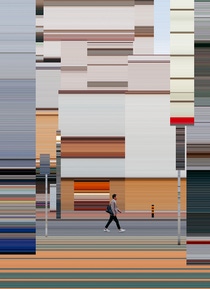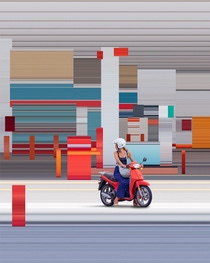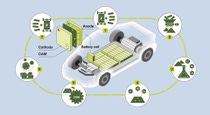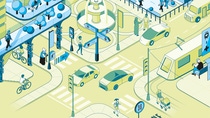Media
Future of mobility: changing direction
Changing direction: urban traffic of tomorrow
We’re on the eve of a mobility revolution that will greatly alter our urban landscapes. Let’s take a look around the globe at some of the ways that the future of mobility is already being envisioned.
At a glance:
-
To get traffic moving, many cities are developing creative mobility solutions – even sending commuters into the air.
-
Urban space is becoming increasingly scarce.
Therefore, cars should make way for cleaner and more efficient modes of transport. -
In the future, micromobility and social equity must be carefully integrated into the urban transportation mix to ensure that the new flexibility truly benefits everyone.
The world is becoming urbanized
Rush hour in the city: The after-work traffic crawls slowly through the airspace between the skyscrapers, the yellow hover taxis, cargo drones and flying limousines glide at a snail’s pace through the endless canyons of streets. Only a limited number of flying craft are allowed to thread their way into this maze to avoid the risk of air traffic gridlock...
Airspace? Flying taxis? While the scene so cheerfully exaggerated in the 1997 science fiction classic "The Fifth Element" with Bruce Willis remains firmly in the realm of fantasy, there’s something the film and our reality have in common: The world is increasingly fusing to become a city, and urbanization is one of the megatrends of our time. Today, 57 percent of the world’s population lives in cities, and according to U.N. calculations, this will rise to around 70 percent by 2050. It’s a trend that is fueled by several factors: The world’s population is growing, the global south is in the grip of a rural exodus, and people in the north are being drawn to city life. However, as cities increasingly sprawl, their infrastructure needs to keep pace, especially for transportation. Efficient urban mobility networks are crucial for people to be able to get to work, enjoy their leisure time and connect with each other. In short, mobility is essential to allow us to participate in society and play a part in shaping it. But how can we integrate as many people as possible, including those who live in the remoter outskirts of these rapidly growing metropolitan areas? The following examples offer solutions.

Flying high: paving new paths
As a passenger, the first thing that strikes you is the absolute silence. While the city seethes below your feet, you float serenely in the glass cocoon of the cable car cabin above the rooftops and streets. Traveling to work at a height of 50 meters is all part of the ordinary commute for many people in La Paz. In the metropolitan area around the Bolivian capital with its roughly two million inhabitants, people take the "Teleférico" just like they would take the subway or bus elsewhere.
The first three lines of the urban cable car started operating in 2014, and today it is the largest system of its kind in the world, covering a network of 33 kilometers. Around 1,400 cabins glide over the densely built-up residential areas on ten lines, with an average of around 300,000 passengers using the aerial mass transportation system every day. It is also a smart solution that makes what was long considered an insurmountable problem literally disappear into thin air: The greater La Paz area is 3,200 to 4,100 meters above sea level, and there are almost 1,000 meters in altitude to cover between the lowest and highest districts. Accessing them by road or subway is topographically impossible. Traveling up or down by bus or shared cab is an ordeal on narrow roads, and it’s time-consuming and dangerous to boot. So, the Teleférico has become the backbone of local public transportation, whisking residents from outlying areas far from the city center into the city in around 30 minutes. As this instantly improves the chances of finding a job and boosts social inclusion, countries such as Mexico, Colombia and Madagascar have taken note and are rolling out similar projects based on La Paz’s pioneering cable car system.
The population density of growing cities is constantly increasing, and the available urban space is becoming scarcer and scarcer.“

Redesigning public spaces for everyone's benefit
La Paz is a great example of a viable approach to new types of mobility and identifying solutions that do not follow the most obvious path, for instance solving traffic problems by building new roads or expanding existing ones. According to Mimi Sheller, an American mobility researcher and sociology professor, this has been one of the cardinal mistakes in urban transportation planning. And not the only one. "For decades, many cities have geared their infrastructure towards a single group of road users: commuters who drive from A to B, from home to work and back," says Sheller, who is Dean of the Global School at Worcester Polytechnic Institute in Massachusetts, United States. "This ignored the mobility needs of others, especially those of many people who do different types of care work and therefore often have to make many stops along the way. But transport planning took little account of this."
Urban space is becoming scarcer and scarcer
Until now, that is, because times are changing. And this change is essential if cities are to offer as many people as possible a wide range of mobility options, rather than just certain groups. However, it usually requires the layout of traffic areas and public spaces to be rethought. "The population density of growing cities is constantly increasing, and the available urban space is becoming scarcer and scarcer," says Lynette Cheah, Professor of Sustainable Transport at the University of the Sunshine Coast in Queensland, Australia.
"This will eventually lead to the inevitable question: Do we want to keep sharing this precious resource with big cars – or rather with public transit and small alternative modes of transportation that are cleaner, more efficient and take up significantly less of the space we need for people?"
Making space: cars need to step aside
City authorities around the world are coming up with answers to this question (we showcase pioneering examples here) and have their sights set on reducing car traffic in favor of other modes of transport. Paris is one of the pioneers: For a good decade now, the city council of the French capital has been pushing to become a 15-minute city, closely followed by Portland, United States, Melbourne, Australia and Shanghai, China. The concept is straightforward: The aim is to allow most Parisians to reach important everyday points of contact such as schools, authorities, doctors’ offices, recreational or sports facilities within a quarter of an hour on foot, by bike or by public transportation. The city council is tackling this by adding new cycle routes to the famous boulevards, many of which are already subject to a 30 km/h speed limit, by doubling the size of the metro network to 450 kilometers, and with plans to ban the last gasolinepowered vehicle from the city center by 2030. Norway is pursuing a similar program: The e-mobility pioneer in northern Europe has set itself the goal of having zero new combustion vehicles registered after 2025. In addition, around 30,000 autonomous shuttle buses are to be added to the local transportation network at the beginning of the next decade. Milan, Zurich, London and Copenhagen are also pushing ahead with mobility changes that include congestion charges, parking restrictions in the city center, or a combination of both. Singapore is taking a particularly resolute approach: The citystate is rolling out driverless subways and wants to build stations close to 80 percent of its citizens. Meanwhile, only one in ten people still own a car here: "If you want to register a vehicle in Singapore, you have to pay four times the purchase price in taxes," says Cheah.

Friction point: How relevant is the car to quality of life?
But what applies to car ownership in Singapore is quite different elsewhere in the world. Sociologists and mobility researchers have revealed in numerous studies how important a car is for professional success and social status, but also for individual satisfaction. It is hardly surprising that in the car-centric United States, car ownership has been shown to significantly increase the chance of a better job and salary. The 2020 study "Does lacking a car put the brakes on activity participation?" by Eric Morris, Evelyn Blumenberg and Erick Guerra provides enlightening insight. The U.S.-based professors of urban planning used data from various countries to show that people who do not have access to a private vehicle are significantly less likely to take part in activities outside the home, such as sports or volunteering. They also found that these people are most likely to miss out on activities "associated with high subjective wellbeing" and that "constrained mobility comes with significant emotional costs." In other words: The lack of a car leads to a lower quality of life. So do we need cars – or do we need fewer cars? There is no one-size-fits-all solution; ultimately, it all comes down to trial and careful calibration.
Staying flexible – while considering everyone's needs
Following protests from citizens and businesses, Oslo’s city council was forced to abandon its initial plan to ban cars from the city center. The mayor of Paris, Anne Hidalgo, has every major proposal legitimized by public consultations, so far with success. "If new transportation concepts are met with disapproval, you have to investigate whether they might make life more expensive or more difficult for some people. Or whether the plans were perhaps not communicated well," says Sheller. "And you have to take time to find out in pilot projects: Do the measures actually reduce traffic? Do they improve air quality? Are they even affordable? If all this is the case, most people will accept changes, often even learn to appreciate them, but you have to include people on the way to this goal."
Circle of power
People around the world are increasingly opting for electric vehicles. This reduces emissions and is good for the climate, but also poses new challenges. The demand for lithium-ion batteries has increased, as has the quantity of raw materials required, such as lithium, nickel, cobalt and manganese. This means that recycling is needed in order to grow and promote electromobility in the long term. BASF is building networks in Germany and the United States to enable a sustainable circular economy, which uses recovered raw materials to produce new battery components. For instance for cathodes, a main battery component, and the one where the electrochemical reaction takes place that triggers the flow of electricity to power electric vehicles.

Shredding and separation
The old batteries are shredded, sieved and dried, with materials like plastic removed. The resulting compound is called black mass.
Installation in vehicles
The circle is complete: Car manufacturers combine the modules into battery packs and install them in new electric and hybrid vehicles.
Metal extraction
Using a chemical process, BASF extracts high-quality recyclable metal salts containing lithium, nickel and cobalt from the black mass.
Safe disassembly
Spent lithium-ion batteries are dismantled and deep-discharged to eliminate the risk of fire and explosion.
Supply to manufacturers
BASF supplies the cathode material to battery cell manufacturers who produce modules for new lithium-ion batteries.
Cathode production
BASF processes these precursors into cathode active materials (CAM), a key component of lithiumion batteries, as it influences their performance, safety and cost.
New precursors
The extracted metal salts (and new primary raw materials) are used to produce new precursors for cathode materials.
We need an infrastructure that prioritizes the most sustainable and efficient means of transport.“
Filling the gap for the "last mile"
From rental bikes to e-scooters: Within the space of only a few years, micromobility has taken off in many cities around the world. And with good reason: Thanks to their flexibility, alternative forms of transport find niches in many places. One example is the Gojek scooter cab service, which is practically ubiquitous in Indonesia. Customers use an app to book a scooter driver who maneuvers them through congested streets, past never-ending streams of traffic and miles of traffic jams. In addition, these and other mobility options such as e-scooters or rental bikes can close the gap between private vehicle ownership and local public transportation services, the keyword being the "last mile." However, this will only work "if micromobility solutions are carefully managed by the cities," says mobility expert Dr. Maya Ben Dror, co-founder of the Global New Mobility Coalition at the World Economic Forum. "If, on the other hand, e-scooters or rental bikes are not consciously integrated into the urban transportation mix, their proliferation can lead to increased competition for scarce space or to confrontations with pedestrians – and quickly undermine the benefits of shared mobility and turn them into their opposite." There are already examples of this: Paris and Melbourne have banned rental e-scooters due to safety concerns, while London, Copenhagen and other cities tolerate them, but impose strict conditions. For Ben Dror, this is the result of a systemic failure: "For shared mobility systems to work, you need an infrastructure that prioritizes the most sustainable and efficient means of transport. Bicycle lanes and e-scooter parking zones can help to avoid conflicts."

Sheller believes that the first step should be to evaluate the benefits of such mobility services for the community. "Anyone who wants to expand micromobility and allow more and more new services should first ask themselves: Who are these systems actually aimed at, whose needs are they targeting? We know from surveys that many people don’t have the confidence to use these vehicles or that they don’t feel able to handle the necessary apps and digital platforms. And in the end, this does not lead to greater mobility equality, but rather to new inequalities."
Smartly connected: one city for all
Does the service deliver benefits? Is the technology easy to use? And is it financially viable to operate? These are core questions that will determine how shared mobility develops in many cities. It is still a young, highly competitive field of business in which takeovers and bitter competition are so frequent that even experts are reluctant to make forecasts. To ensure longterm success, it is crucial that sharing services do not remain isolated solutions that users book and pay for individually; instead, to make them attractive and convenient, they should be used and billed in conjunction with other mobility services. Examples of how modal transport – from e-scooters and car-sharing vehicles to buses and trains – can be intelligently linked include the DiDi platform, which is used across countries in the Asia Pacific region and Latin America, the Transit app for more than 600 cities worldwide, and the Rome2Rio platform, which can be used globally.
As these examples illustrate, there are mobility concepts and solutions all around the world that can empower us to master the challenges of navigating urban life, even in rapidly growing metropolitan areas. What these solutions are unlikely to include are flying yellow cabs hovering in traffic jams up in the air. Futuristic scenes like these seem destined to remain firmly parked in the world of science fiction.



